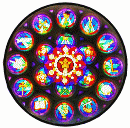STUART, Rev. John: 1740 - 1811
Tile ordered and paid for by N.B. Stuart, Quebec, October 1888
John Stuart was born in 1740 near Harrisburg, Pennsylvania. His parents, Andrew Stuart and Mary Dinwiddie, had emigrated from Ireland to America prior to 1740. John was raised in a strict Presbyterian household. He graduated from the College of Philadelphia in 1763, taught school for several years and then returned to the college for a Masters Degree in 1770. Having decided to become a minister, he travelled to England and was ordained in the Anglican Church, much to the chagrin of his Presbyterian father.(1)
After returning to America, Dr. Stuart was assigned to the Mohawk parish at Fort Hunter, New York and by 1774 he was able to conduct services in the Mohawk language. It was at this time that he became a close friend of the great Indian chief Joseph Brant with whom he later collaborated to translate St. Mark’s Gospel into Mohawk. Reverend Stuart’s copy is now displayed in St. George’s Cathedral, Kingston.
In 1775, John Stuart married Jane Okill (1747-1821) of Philadelphia. Once the American Revolution had begun, Reverend Stuart was under suspicion for his Loyalist sympathies. He was continually harassed and his home was plundered. He applied for and received permission to leave the country; in 1781, he and his wife and three small children made the difficult journey to St. John, Quebec. The family settled in Montreal where John Stuart became chaplain to the 2nd battalion of the King’s Royal Regiment of New York and operated a school open to all denominations. In 1785 he moved his family to Cataraqui (Kingston) and established himself as a missionary and as Chaplain to the Garrison. Until his death Reverend Stuart served the area with great distinction. Governor Simcoe appointed him the first Chaplain of the Legislative Council of Upper Canada. He continued as Chaplain to the Garrison and undertook a three-fold charge to minister to the soldiers of the garrison, the civilian population along the shores of the Bay of Quinte and beyond, and to his loyal Mohawks, newly arrived from Fort Hunter and other areas of northern New York.(2) He devoted his prodigious energy to his parish for over twenty-six years. Bishop John Strachan delivering the eulogy at his funeral, described him as “the father of the Episcopal Church in this Province.” Reverend Stuart’s land grant (now in downtown Kingston) was the site of the first St. George’s Cathedral.
Dr. Stuart and his wife, Jane Okill, had five sons and three daughters: George born in 1776, John Jr. born in 1777, James born in 1780, Jane who died as an infant, Charles born in 1782, Jane born in 1784, Andrew born in 1785 and Mary born in 1787. Their eldest son, the Reverend George Okill Stuart, graduated at Cambridge, England in 1801 and eventually became Archdeacon of Kingston.
Reverend Dr. John Stuart, U.E., died August 15, 1811 in Kingston, Upper Canada.
1. “Stuart, John,” Dictionary of Canadian Biography Online, Vol. V, via www.biographi.ca.
2. Paul Banfield, diocesan archivist, The Rev. John Stuart: Loyalist, builder, missionary, faithful leader, Dialogue, May 1998.

